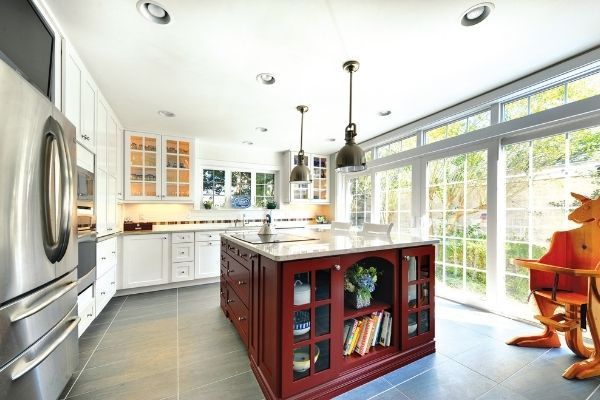Lighting is a key part of kitchen design that can influence both the look and mood of the entire room. To customize your kitchen lighting according to your unique style, you can adjust the brightness, hue, and placement of your light fixtures with a kitchen remodel. You can also install alternative sources of illumination like windows to brighten your kitchen with natural lighting.
In addition, check out our Personalized Design experience if you want customized help with your lighting and other aspects of kitchen design. The Personalized Design experience allows you to work directly with one of our professional designers, who can help you plan a remodel that will bring your dream kitchen to life.
To be a part of the Personalized Design experience, schedule an appointment online or over the phone. In the meantime, keep reading to learn how to brighten your kitchen with natural lighting.
How to Bring Natural Lighting into the Kitchen
Brightening your kitchen with natural lighting means bringing a little sunshine into your home. There are many ways to direct those golden rays into the room, from skylights to glass doors and more. What all these natural lighting fixtures share in common is that they allow illumination from the outdoors to come inside, brightening your kitchen with natural lighting in the process.
Every type of natural lighting fixture is a little bit different from the others, and each has its own particular strengths. Learning about the most common natural lighting fixtures can help you decide which one is right for your kitchen.
Windows
A popular way to bring natural light into your kitchen is to install a kitchen window. Kitchen windows provide a large opening for sunshine while still protecting you from outdoor irritants like allergens, insects, and inclement weather. For all those reasons, installing a kitchen window is a great way to increase the natural lighting in your kitchen.
Plus, you have the opportunity to incorporate color into your kitchen by choosing decorative curtains.
A common place to install a window during kitchen remodels is above the sink, but we can help you add windows wherever you would like to place them.
Exterior Doors
Exterior doors can serve multiple purposes in your kitchen. Many homeowners install exterior doors as part of their kitchen remodel in order to have easier access to the lawn or a patio. After all, there’s nothing quite like enjoying a fresh cup of coffee while you watch the sunrise.
Homeowners might also choose to install an exterior door in their kitchen if they want to optimize their outdoor cooking and grilling experience. You can learn more about designing a kitchen that compliments outdoor cooking activities by reading these 5 Tips to get Your Kitchen Ready for Entertaining.
Exterior doors do more than just give your kitchen a quick and easy exit, though. They can also serve as a natural lighting fixture when they are made out of glass or with glass panels. So, consider installing an exterior door if you want to add both functionality and sunshine to your kitchen.
Skylights
While less common than windows or doors, skylights can be a great source of sunshine. These lighting fixtures are similar to kitchen windows. However, whereas windows go in walls, skylights go in the ceiling.
The placement of skylights gives them a unique advantage. Since these natural lighting fixtures face up, rather than east, west, etc., they are more likely to catch sunlight evenly throughout the day. Plus, even once the sun disappears behind the horizon, skylights offer a great view of the night sky.
This lighting fixture is perfect for kitchens with access to the roof. For kitchens that sit below another room, light tunnels can bridge the gap between your roof and the room.
Light Tunnels
Even if your kitchen does not have direct access to the roof of your home, you can still enjoy a little sunshine from your ceiling thanks to light tunnels.
Light tunnels are essentially reflective tubes, which usually run between a given room and the roof. Once installed, these tubes direct light inside, diffusing the sun’s rays at the same time. Because the illumination of light tunnels is diffused, these natural lighting fixtures are perfect for ambient lighting.
Ambient light is identified by its soft, diffused character, and it tends to give the kitchen a calmer, more relaxed feeling. This type of illumination spreads evenly throughout the kitchen and creates minimal shadows.
Ambient light is often paired with sharper, brighter lighting fixtures that help you see and complete kitchen activities more clearly. By layering ambient and direct lighting, you can customize the mood of your kitchen without compromising functionality. At Cabinet World, we can help you find the right combination of lighting fixtures that suits you perfectly.
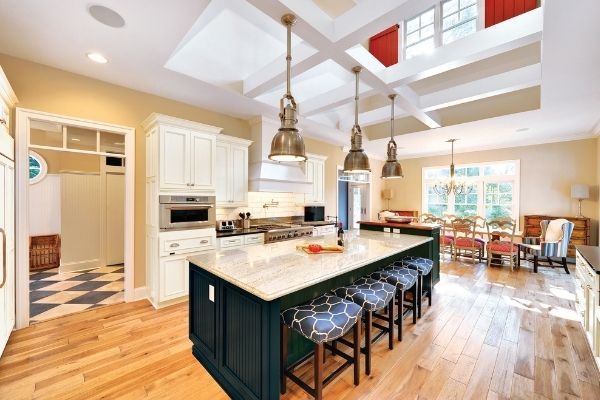
How to Increase the Natural Lighting in Your Kitchen
Lighting fixtures such as windows, doors, skylights, and light tunnels work great for bringing the sunshine into your kitchen. They work best when placed in a kitchen that is designed for natural lighting. By incorporating just a few lighting tricks into your kitchen design, you can get the most out of your natural lighting fixtures.
Reflective and Light-Colored Surfaces
When light hits an object, much of that light bounces off the surface and spreads to other areas. However, the object does absorb some energy, making the light dimmer after impact.
Thankfully, reflective surfaces such as glass and metal don’t absorb as much energy as matte or opaque objects do. Instead, they reflect both the light and most of its energy. You can use this feature of reflective surfaces to your advantage as you brighten your kitchen with natural lighting.
For example, if you install glass doors on some of your cabinetry, you can increase the brightness of natural lighting in your kitchen. Another way to improve illumination in your kitchen is to choose metallic appliances and/or place decorative mirrors throughout the room.
Besides reflective surfaces, a light color pallet can help the natural lighting in your kitchen stay bright. Darker surfaces, such as blue, green, and other cool colors, tend to absorb more energy than lighter hues.
Light-colored cabinetry also happens to be What’s Hot in Kitchen Design. While there are Alternatives to White Kitchens, lighter hues are sure to trend in the next few years. Even if you choose to brighten your kitchen with artificial lights, opting for white and other light colors during your next kitchen remodel can give the room a stylish makeover.
Streamlined Layout
Light wants to travel in a straight path, and it often loses energy if it has to change course or bounce off obstacles. Thankfully, you can help natural lighting stay bright when you design your kitchen around a streamlined layout. A streamlined layout, with minimal barriers and curves, allows natural lighting to travel through your whole kitchen without meeting a significant obstacle.
Of course, the right kitchen layout for your home depends on your personal tastes and goals. Whether you want a streamlined design or something else entirely, our designers can help you make it happen. When you work with us, we help you navigate the Layout Considerations for Kitchen Design and avoid common layout mistakes.
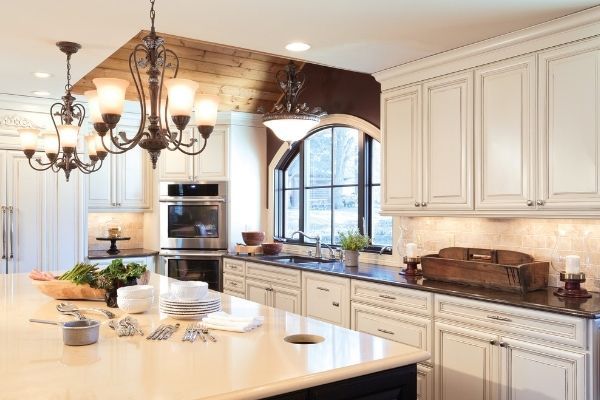
Important Considerations for Natural Lighting
When bringing natural lighting into the kitchen, it’s important to review a few considerations. Taking everything into account ahead of time will help you make the best plans for your kitchen remodel. In addition, reviewing important considerations for natural lighting could save you from potential kitchen lighting mistakes.
Let’s take a look at two factors that you should consider as you plan to brighten the kitchen with natural lighting: dependability and temperature changes.
Natural Lighting and Dependability
Since the sun moves throughout the day, a natural lighting fixture may not provide the same intensity of illumination over a 24-hour period. As a result, natural lighting fixtures may need a little help from their artificial counterparts to give you dependable illumination in the kitchen.
A great way to bolster the natural lighting in your kitchen is to install light-sensing artificial lights. These lighting fixtures automatically adjust their intensity based on how bright the room is already. That way, you can enjoy sunshine in your kitchen without needing to worry whether or not natural lighting will be sufficient.
You can also increase the dependability of your natural lighting fixtures by installing them where they will receive the most amount sunshine for the greatest amount of time.
A west-facing window will offer the best illumination in the afternoon, but not in the morning. An east-facing window will provide more light in the morning than it will in the evening.
To get the most out of your natural lighting fixtures, opt for a north or south-facing window, depending on whether you live in the southern or northern hemisphere.
In the northern hemisphere, for example, the sun will favor the southern sky. It will rise in the southeast and set in the southwest, which means that a south-facing window will give you the most natural lighting if you live in a northern hemisphere.
Natural Lighting and Temperature Changes
While natural lighting in the kitchen can brighten the room, it could also raise the temperature. Thankfully, you can minimize the heating effect of natural light when you diffuse the rays of sunshine entering your kitchen. For example, installing light-weight curtains over a window or door will allow natural light inside while still reducing its intensity.
Some natural lighting fixtures are even built to diffuse light, such as light tunnels. In addition, many windows, doors, etc. are designed to trap cool air in your home and block the hot air outside. These lighting fixtures will help you brighten your kitchen without baking the room.
You might also install lighting fixtures in places that do not receive constant or direct sunlight if you want to prioritize temperature over dependability. Adding a north-facing window, for instance, will help you control the temperature in your kitchen without giving up natural light.
Considering both temperature changes and dependability is important, as you’ll want to align the factors of natural lighting with your own priorities and preferences. Thankfully, the benefits of natural lighting show that this careful planning is well worth the effort.
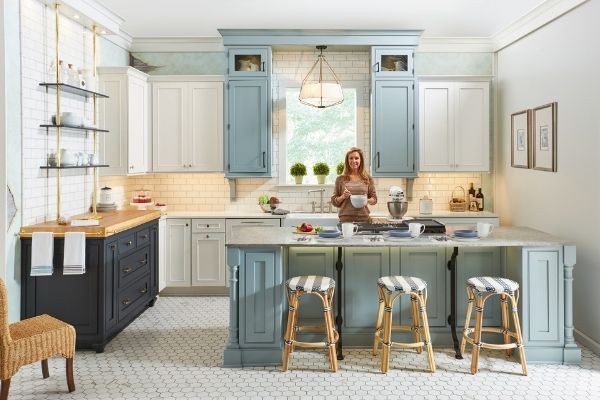
Benefits of Natural Lighting in the Kitchen
Natural lighting can do wonders in the kitchen, from adding aesthetic appeal to lifting the mood of the whole room. These benefits all add to the style of your home and make for great reasons to start incorporating natural lighting in your kitchen.
Even beyond the fashion appeal, there are even a number of practical benefits to brightening your kitchen with natural lighting.
To start, adding natural lighting to your kitchen may help you lower your energy bill. By providing light from the sun – free of charge – natural lighting reduces the need spend electricity on artificial lights.
The sunshine will also give you a Vitamin D boost as you work in the kitchen. Vitamin D can in turn improve your mood and energy levels – especially in colder seasons.
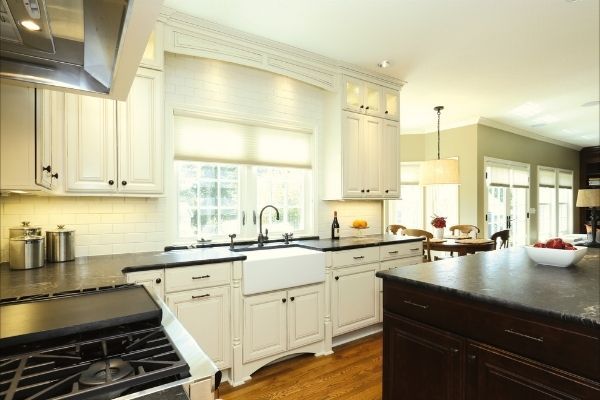
Brighten You Kitchen with Cabinet World
At Cabinet World, we’re ready to help you brighten your kitchen with natural lighting. To learn more about what we can do for you, contact us online, over the phone, or at one of our Pittsburgh Kitchen & Bath Design Centers. You can also check us out on Facebook and Instagram to see examples of our works and more.
Think a friend would like to learn about natural lighting in the kitchen? Share this post via social media, email, or text at the links below! You’ll also find additional tips, tricks, and advice on our blog page. There, you can learn about The Remodeling Process, Made Easy, How to Create a Family Friendly Kitchen, and more.

